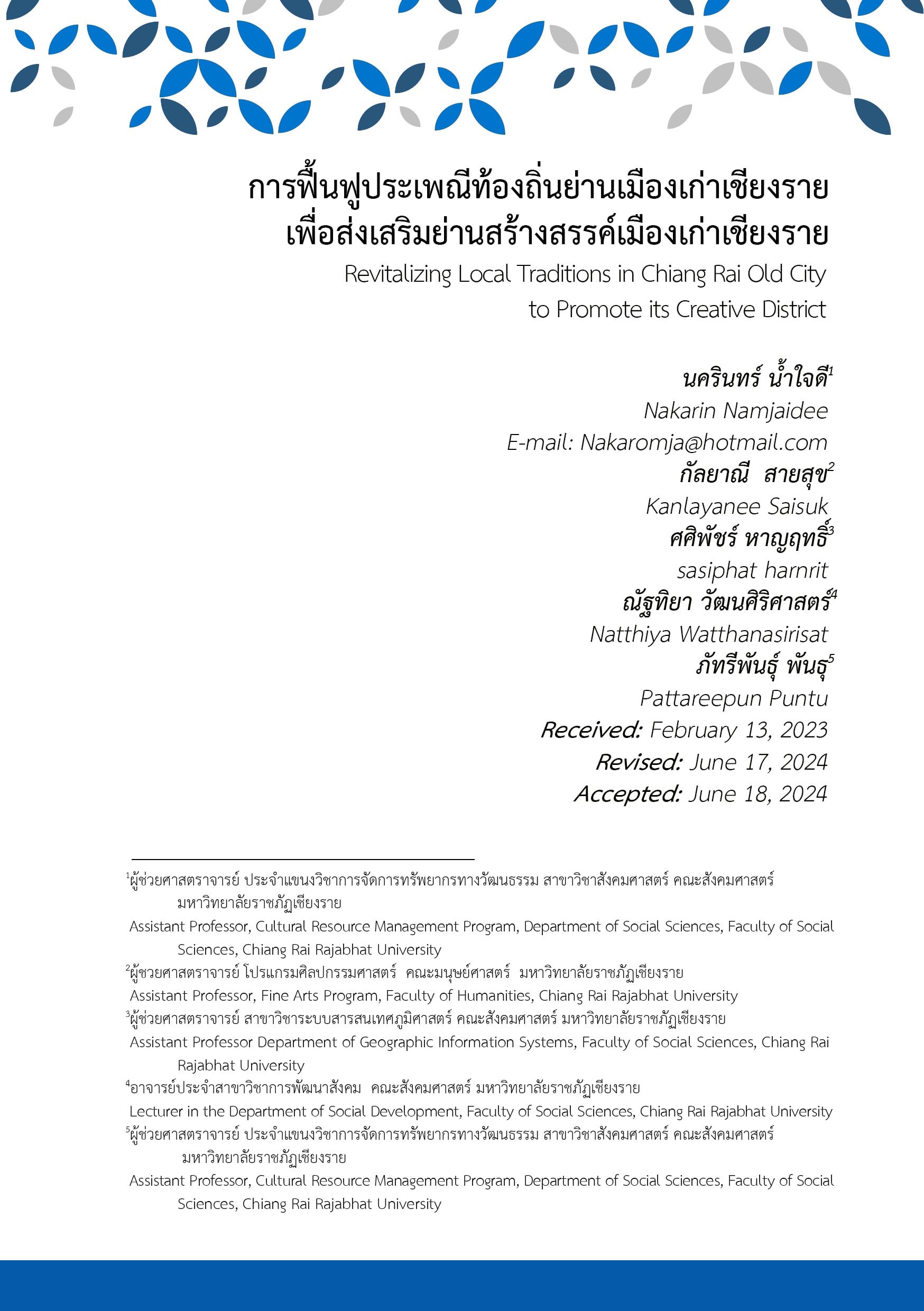Revitalizing Local Traditions in Chiang Rai Old City to Promote its Creative District การฟื้นฟูประเพณีท้องถิ่นย่านเมืองเก่าเชียงราย เพื่อส่งเสริมย่านสร้างสรรค์เมืองเก่าเชียงราย
Main Article Content
Abstract
This research aims to preserve and revitalize the important local traditions of Chiang Rai Old City to promote the Chiang Rai Old City area as a creative district. The study employs qualitative research methods including physical surveys and in-depth interviews with Buddhist, Christian, Islamic, Brahmin, and Hindu spiritual leaders, as well as civil servants involved in cultural work, local academic officers, artist network groups and cultural entrepreneurs. The data are analyzed together with information from documents and processed to gather basic information regarding the importance of local traditions in Chiang Rai Old City area. The results found that (1) there are 49 traditions in Chiang Rai Old City; (2) the most significant tradition according to the evaluation is the “Tradition of the 8th lunar month, going into the 9th lunar month, Sai Khan Dok Sadue Mueang Chiang Rai”; and (3) guidelines for the conservation and revitalization of traditions are as follows: 1. Promoting the significance of areas through providing historical knowledge; 2. Integrating ritual knowledge with modern contexts; 3. Revitalizing traditional events in conjunction with tourism promotion; 4. Revitalizing traditions through city-level working groups; and 5. Creatively preserving local flowers in traditional events.
Downloads
Article Details

This work is licensed under a Creative Commons Attribution-NonCommercial-NoDerivatives 4.0 International License.
References
Bernard, M. F., & Jokilehto. J. (1998). Management guidelines for world cultural heritage sites. Rome: ICCROM. pp.115-130.
Boonyasurat, W. (2015). Community-based conservation of Viharn Phra Chao Pun Ong, Wat Pongsanuk. Lampang: Lesson learned by the little people in conservation group, 7(2), 92-109.
Chaisuryan, K. (1943). Ghosts of Lanna Thai people. Bangkok: Prachan Printing House.
Chamchit, C. (2000). Diary of Chiang Rai city. Chiang Rai: Chaiyaran Printing Factory.
Chiang Rai Rajabhat University. (2000). Chiang Rai 100 years ago. Bangkok: Siam Advertising and Printing.
Chumphon, S. (2019, June 21). Interviewed by Nakarin Namjaidee [Tape recording]. The descendants of the Chiang Rai bosses and the successor of the ceremonial banquet of the city’s greatgrandfather, Mueang Chiang Rai District, Chiang Rai Province.
Hongkham, C. (2021, August 16). Interviewed by Nakarin Namjaidee [Tape recording]. Former leader of Koh Loi community, Mueang Chiang Rai District, Chiang Rai Province.
Hongsuwan, P. (2015). Creative traditions in contemporary society. Bangkok: Princess Maha Chakri SirindhornAnthropology Centre (Public Organisation).
Kittisophon, N. (2022, May 28). Interviewed by Nakarin Namjaidee [Tape recording]. Leaders perform rituals., Mueang Chiang Rai District, Chiang Rai Province.
Jaima, W. (2017). Temples in Chiang Rai Municipality. Chiang Rai: Chiang Rai Municipality.
Lertcharnrit, T. (2016). Cultural Resource Management. Bangkok: Princess Maha Chakri Sirindhorn Anthropology Centre (Public Organisation).
Manasam, M. (2011). The study of clothing pattern in Lanna Ritual “Fon Phi” [Spiritual Dance]. Chiang Mai: Silkwornbook Publisher.
Na Thalang, S. (2015).Folklore in a transboundary context: Thai Yai Poi Festival in Chiang Mai. Bangkok: Chulalongkorn University Printing House.
Phungpracha, E. (2002). Rahu : the invented tradition of Wat Srisathong (Master’s Thesis). Thammasat University, Bangkok.
Piamsuwannakit, S. (2022). Cultural capital managing for improve a local economy of creative district at Chiang Rai Old Town. Chiang Rai: Chiang Rai Rajabhat University.
Praichanchit, S. (2010). 10 years of Community Archeology: Commemorative on the occasion of making merit on the first decade anniversary of the community archeology event 1999-2010. Bangkok: Archaeopen, Center for the Study of Community Archeology Development.
Rojsaengrat, S. (2023, May 23). Interviewed by Nakarin Namjaidee [Tape recording]. Wat Klang Wiang Committee, Mueang Chiang Rai District, Chiang Rai Province.
Sangkhanayok, W. (1943). Thao Hung or Truong. Bangkok: Mitthai Printing Press.
UCCN. (2019). Creatives Cities of UNESCO for Sustainable Development. Retrieved November 2, 2020, from https://www.bic.moe.go.th/images/stories/pdf/unesco_uccn_en_180530_final.pdf.
Wachirapho, T. (2021, May 30). Interviewed by Nakarin Namjaidee [Tape recording]. Abbot of Wat Klang Wiang, Mueang Chiang Rai District, Chiang Rai Province.


